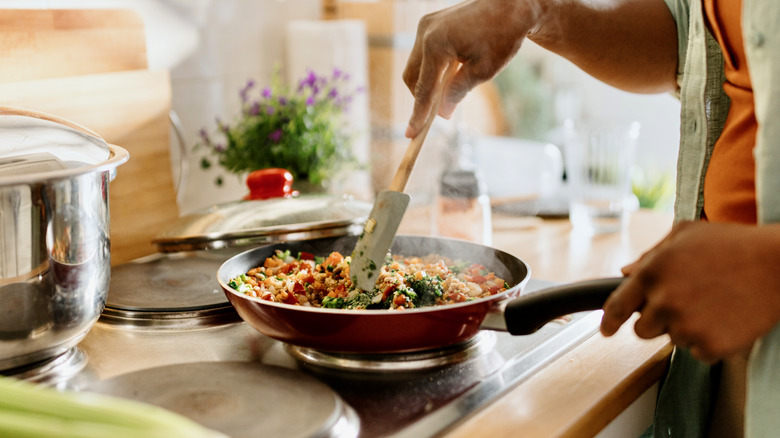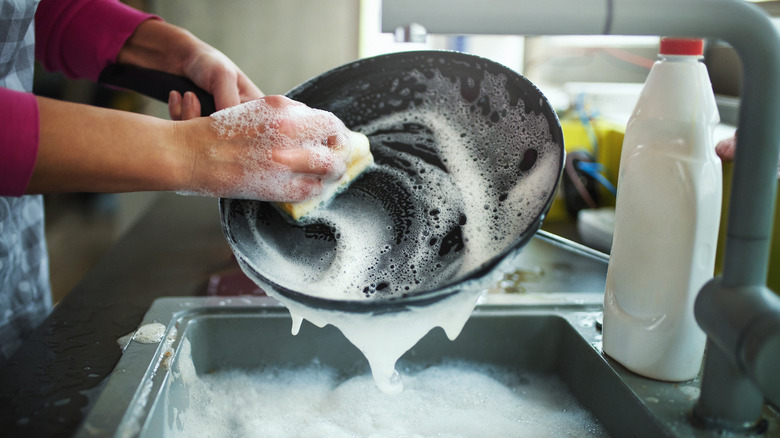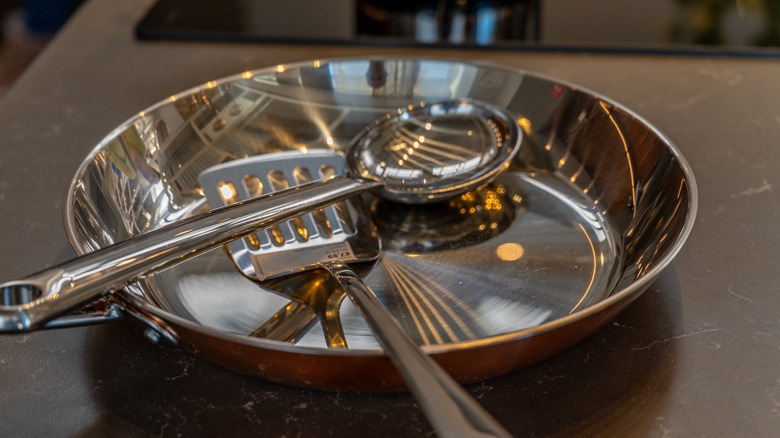Nonstick Vs Stainless Steel: Which Skillet Is Best For Stir-Fry?
Can't decide whether you should use a nonstick or stainless steel skillet for your stir-fry? To tackle this question, let's use the best pan for stir-frying as a standard of measurement: the wok, an old-school cooking pan that has been fine-tuned for ages to nail stir-frying. Firstly, a wok can handle lots of heat, and so can a stainless steel skillet. But heat is only one factor, as a wok also ensures that your food doesn't stick to the bottom of the pan as it cooks. For this second feature, nonstick skillets are more similar to woks.
So both types of skillet mimic certain wok characteristics that contribute to a perfect stir-fry, but does this make them equally useful for the job? Certainly not! The short answer is that stainless steel skillets have an edge. That being said, each type of skillet still has more distinctive characteristics to consider, including utility, health concerns, and how they affect taste.
Nonstick skillets are better for delicate foods, rather than stir-frying
There's a myth that you can't get a good sear on meat using a nonstick frying pan. In reality, you can get a good sear with anything between 350 degrees Fahrenheit and 500 degrees Fahrenheit, which an aluminum skillet can take. The actual concern has more to do with the Teflon nonstick coating, as PTFE degrades at high temperatures over 450 degrees Fahrenheit, causing potential health concerns. Also, if you don't let your pan cool down before washing, thermal shock may lead to rapid expansion and shrinking of the metal base, which can damage the coating. For that reason, it's advised to use nonstick skillets for delicate foods such as fish, eggs, grilled cheese, quesadillas, and pancakes that require 350 degrees Fahrenheit and below. It's also about how, for inexperienced home cooks, not having a nonstick surface to minimize the messes might be too bothersome.
Another concern is that aluminum is reactive to acids. This means that if the nonstick coating on your frying pan is chipped, stir-fries with things like tomatoes, citrus, or wine will impart a metallic taste onto the food — not yummy. This is not to mention the health concern of aluminum leaking into your food. Stainless steel skillets, on the other hand, are completely non-reactive and make for the better choice.
Stainless steel skillets are better for stir-frying, as long as they don't stick
Both nonstick and stainless steel skillets heat up fast and evenly to get that quick browning and nice smell on our meat and veggies. So why do some people insist that searing in a stainless steel pan is better? It could be that the shine makes it easier to see the browning. Or it could be that people just prefer the crisped up bits that stick to the bottom of the pan.
A stainless steel skillet would be the best for stir-frying as long as food just doesn't stick to it, right? Here's the thing: You can actually prevent anything from sticking to your stainless steel skillets if you know how. By letting your stainless steel skillet get hot enough before adding oil, nothing will stick to it. To do this, preheat your pan on medium heat, which is around 350-375 degrees Fahrenheit.
Don't have an infrared thermometer? Just pour a spoonful of water (or drizzle it with your hand like Salt Bae) into the pan. If the water forms droplets rather than just a puddle and you can swirl them around, then the pan is hot enough — this is called the Leidenfrost effect. Try frying some eggs with this method, and you'll see the eggs just slide right off the pan without a hitch. Then, with a stainless steel skillet in hand, just master your tossing, and you'll be ready to take on any stir-fry recipe.


